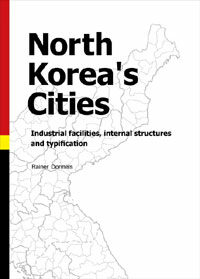
North Korea's Cities: Industrial facilities, internal structures and typification
- 개인저자
- Rainer Dormels
- 발행사항
- Paju-si: Jimoondang, 2014
- 형태사항
- 544 p. :. 26cm
- ISBN
- 9788962971675
- 청구기호
- 539.73011 D712n
소장정보
| 위치 | 등록번호 | 청구기호 / 출력 | 상태 | 반납예정일 |
|---|---|---|---|---|
이용 가능 (2) | ||||
| 1자료실 | G0015394 | 대출가능 | - | |
| 1자료실 | G0015395 | 대출가능 | - | |
- 등록번호
- G0015394
- 상태/반납예정일
- 대출가능
- -
- 위치/청구기호(출력)
- 1자료실
- 등록번호
- G0015395
- 상태/반납예정일
- 대출가능
- -
- 위치/청구기호(출력)
- 1자료실
목차
Acknowledgements
I. Introduction
I.1. Overview of topics, objectives and methods
I.2. Previous research and sources about the cities of North Korea
I.3. Basic information on provinces and cities in North Korea
I.3.1. Changes in the boundaries of the provinces
I.3.2. Formation, development and resolution of the province independent cities
I.3.3. Backgrounds of the administrative transformations
II. North Korean cities
II.1. The location of North Korean cities and their physical-geographical factors
II.2. Distance from the capital
II.3. The development of the modern Korean city network
II.3.1. Phase 1: The colonial urban system (1910-1945)
II.3.2. Phase 2: The development of inland cities (1945-1967)
II.3.3. Phase 3: Development of the capital region around Pyongyang (1969-1990)
II.3.4. Phase 4: Creation of cities in the periphery as a regional balance (1991-2001)
II.4. Classification according to population, area size, and shares in “urban” population
III. Industrial companies in the cities
III.1. Introductory remarks
III.1.1. Special features of the sources
III.1.2. Approach of presenting the results of research to the industrial companies in the cities
III.1.3. Research limitations and possible sources of error
III.2. KOFC (2010)
III.2.1. Total number of companies
III.2.2. Total number of companies in relation to population
III.2.3. Important companies
III.2.4. Industries
III.2.5. Conclusion
III.3. MOU (Who’s who in North Korean important institutions and organizations 2012)
III.3.1. Total number of companies
III.3.2. Total number of companies in relation to population
III.3.3. Important companies
III.3.4. Industries
III.3.5. Conclusion
III.4. IPA (Encyclopedia of North Korean Geography and Culture) (2003)
III.4.1. Total number of companies
III.4.2. Total number of companies in relation to population
III.4.3. Important companies
III.4.4. Industries
III.4.5. Culture
III.4.6. Conclusions
III.5. KCNA (1998-2011)
III.5.1. Total number of companies
III.5.2. Total number of companies in relation to population
III.5.3. Important companies
III.5.4. Industries
III.5.5. Conclusion
III.6. KIET (Yi Sang-chik, Choe Sin-rim, Yi S?k-ki 1996)
III.6.1. Total number of companies
III.6.2. Total number of companies in relation to population
III.6.3. Important companies
III.6.4. Industries
III.6.5. Conclusion
III.7. Overall view
III.7.1. Total number of companies
III.7.2. Total number of companies in relation to population
III.7.3. Important companies
III.7.4. Industries
III.7.5. Results
IV. Profiles of the cities of DPR Korea
IV.1. Methodological Remarks
IV.2. The Profiles of the 27 cities of DPR Korea
IV.2.1. Kanggye
IV.2.2. Huichon
IV.2.3. Manpho
IV.2.4. Sinuiju
IV.2.5. Kusong
IV.2.6. Jongju
IV.2.7. Phyongsong
IV.2.8. Anju
IV.2.9. Kaechon
IV.2.10. Tokchon
IV.2.11. Sunchon
IV.2.12. Pyongyang
IV.2.13. Nampho
IV.2.14. Sariwon
IV.2.15. Songrim
IV.2.16. Kaesong
IV.2.17. Haeju
IV.2.18. Hyesan
IV.2.19. Rason
IV.2.20. Chongjin
IV.2.21. Hoeryong
IV.2.22. Kimchaek
IV.2.23. Hamhung
IV.2.24. Tanchon
IV.2.25. Sinpho
IV.2.26. Wonsan
IV.2.27. Munchon
V. Conclusion
V.1. The cities of North Korea - historical and socio-spatial aspects
V.2. Evaluation of the quantitative studies of the number of industrial companies
V.2.1. Industrial structure of North Korean cities
V.2.2. Different production capacity in the industrial sectors in North Korea
V.3. Evaluation of the quantitative studies of the internal structure of the cities
V.3.1. Centers and sub-centers of the cities
V.3.2. Disappearance of dong
V.3.3. The emergence of new dong
V.3.4. Phases of the development of urbanization in the DPR Korea
V.3.5. Changes in the “urban” population over time
V.4. Regional development trends in the DPR Korea
Bibliography
Appendix 1. Profiles of the 27 cities of DPR Korea (Contents)
Appendix 2. List of industrial companies in DPR Korea (in Korean)

